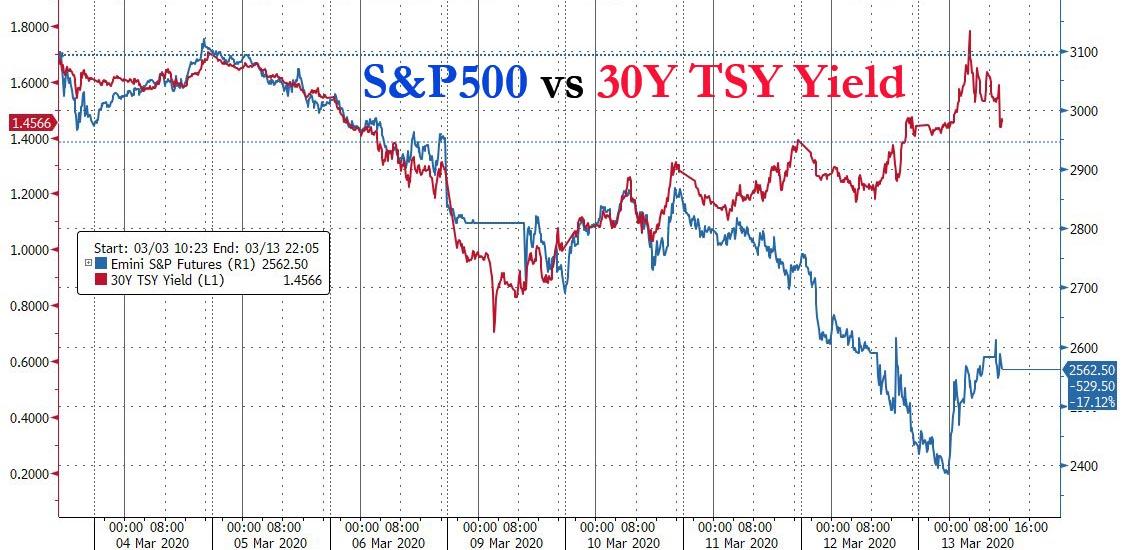BMO: “The Disconnect Between Treasuries And Stocks Is The Most Widely Debated Topic At The Moment”
Authored by Ian Lyngen, Ben Jeffery and Jon Hill, rates stretegists at BMO Capital Markets
A sense of uncomfortable calm has fallen on financial markets overnight following the Fed’s announcement of additional liquidity measures and the PBOC’s drop of the RRR. This isn’t to suggest the price action has been nil; in fact, the curve is steeper with 30-year yields bouncing as high at 1.788% in a sharp reversal of the long bond’s outperformance. Rather, the move might best be characterized as a continuation of the profit-taking and cash-raising trend which has emerged in recent days. In a return to the traditional response to an easing Fed, the steepening of the curve appears to finally be taking hold as 2s/10s reached 45.5 bp overnight and the technical profile shows ample room for further extension. With 10-year yields at 85 bp this morning, the disconnect between the massive selloff in domestic equities and incrementally bearish tone for Treasuries is one of the most widely debated topics at the moment.
It’s far too glib to conclude that ‘markets are broken’ despite how tempting such an observation may be; Treasuries are faced with constrained liquidity and an unwillingness on the part of market makers to step-up risk-taking. This is the exact type of environment in which one would expect investors to step back and allow the repricing to run its course. The anomaly is the magnitude of the dislocations; volatility has spiked as evidenced by the MOVE index which is once again above 150. In more liquid times, we would have anticipated the price discovery process to be more orderly and observe that the longer end of the curve (10s and 30s) has historically traded off global macro expectations of growth and inflation. Flows and supply have become uncharacteristically large drivers in determining the outright level of yields.
Our expectations are for the elevated relevance of positioning to ultimately prove a temporary nuance of a much larger overall repricing; however, for the moment it would be folly to dismiss the liquidity constraints recently revealed in Treasuries as simply noise. As with the movements in global equities, the price action in US rates could transition from ‘reflecting’ a change in investor sentiment to ‘causing’ a material adjustment of macro expectations. Said differently, enough carnage and uncertainty in markets will create the degree of financial losses that can materially define the banking sector – and not in a good way.
The Fed’s primary objective in easing monetary policy in response to the coronavirus was always to provide a bridge of accessible funding to banks and businesses during a period in which corporate profitability will undoubtedly be strained. By pushing down borrowing costs, the objective is to allow/incentivize firms to avoid layoffs as the go-to tool for shoring up the bottom line. This week’s price action has been especially concerning in the context of what it implies for the financial sector as a whole; there are only so many losses that can be papered-over by cheap funding. The labor force will sustain damage from the events of the first quarter, Powell’s objective now is surely to limit the fallout and avoid longer-lasting declines in consumer confidence.
The Fed funds futures market has convincingly priced in another 100 bp of FOMC cuts by next Wednesday’s meeting as the April 2020 contract is trading with an implied rate of 16.5 bp. Technically, this isn’t completely pricing in a 100 bp (that would require a 9 bp rate); nonetheless, it’s close enough for government bond work. There is a contingent in the market anticipating that yesterday’s drop in domestic equities will prove sufficient to warrant another intermeeting ease; this round a full point. This is a distinct possibility as concerns continue to migrate from stocks into credit products as the coronavirus leads to greater state and local government responses. We’re unwilling to dismiss the prospects for an emergency cut ahead of the weekend, after all it’s Friday the 13th, what could go wrong?
Tyler Durden
Fri, 03/13/2020 – 10:52
via ZeroHedge News https://ift.tt/2Qe4zaR Tyler Durden
